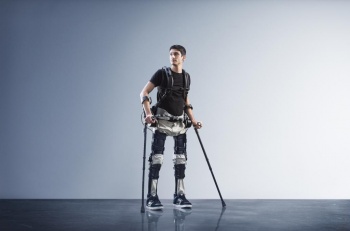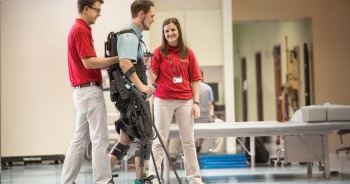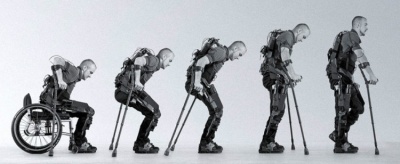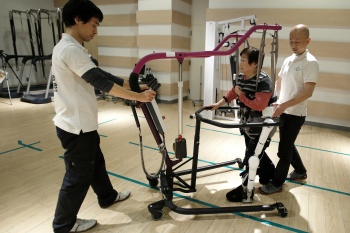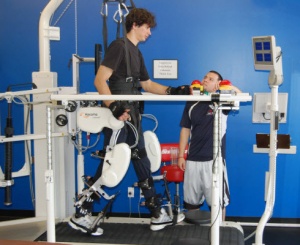Introduction/Overview
Neurorehabilitation, especially for gait, requires a lot of time and physical effort from Physiotherapists. Often requiring two or more people to assist with initial stages of ambulation. This limits the amount of patients that a Physiotherapist can treat, while placing economic burden on health care. [1] Although initially expensive, robotics provide therapists with the possibility to save time, physical effort, and help more patients. Some ways in which robotics can help are: monitoring and controlling movement speed, direction, amplitude, joint coordination patterns, and controlled perturbations; providing weight support with minimal exertion; and offering the potential for more reliable, standardized tests and goniometry measures. [1] Outside of the physical rehabilitation clinic, robotics is showing promise as an assistive device in the form of lower-extremity exoskeletons or Robotic Hip-Knee-Ankle-Foot Orthoses (RHKAFO). [1] This is a relatively young field with much potential. For information regarding the use of robotics for the upper extremity go the Physiopedia page for Demographic
Use of robotics in rehabilitation can benefit many patients. Some of those patients include those with:
Gait training is one of the most obvious implications for lower limb robotic rehabilitation. With current methods of improving gait, multiple therapists are necessary to help the patient move each joint and leg appropriately to get the greatest benefit. Not only is this an expensive and subsequently unrealistic approach for rehab, it is also extremely labour intensive for the therapists to provide this care. With the use of robotics, less therapist attention is required to deliver the same mechanical therapy. With the patient strapped into the robotic device, the therapist will only need to provide supervision and the setting up of the device. [3] This may help teach the patient proper technique with walking right from the beginning, thus avoiding improper gait patterns.
One of the less obvious examples of incorporating robotics into rehabilitation is that of its assessment capabilities. While machines and receptors have been used for years in the rehab field (eg. EMG, force plates), their primary purpose has been to just collect raw data. With the right robotics, measures such as joint angles, velocities, amplitudes can be observed and recorded easily. This information can then be used as an outcome measure to see the progress a patient can make during a treatment plan. [4] Another way robotics can help patients is through improvements in range of motion (ROM) through the reduction of joint impedance. The components of joint impedance, such as passive and reflexive resistance can determine how the joint restriction is occurring. Robotics can then use precise amounts of velocity and amplitude to apply to the patient based on their individual needs. This may help improve ROM using precise forces applied at specific times. The use of continuous passive motion machines are common in rehab to improve joint ROM. However, with more state-of-the-art machines, ROM improvements can, theoretically, be gained at a quicker rate while ensuring patient comfort and safety. [4] Robotics can also be used in improving and determining a patient’s proprioception of their lower limbs. Once the patient’s eyes are closed, the machine can be set up to move a patient’s limb into a position. The patient is then asked to think about the limb’s position and match it to that of the machine. This helps the patient to focus on the positioning of the limb and place the opposing limb in a similar position. The detection of minor passive movement with a limb can also be tested with robotics. Again with the patient’s eyes closed, the strapped-in limb is moved slowly and gradually with the robotics. The patient speaks out once he/she feels the limb has begun to move. This will determine how much movement is required for the patient to feel. Not only can this be used for a sign of treatment but also for a precise assessment tool.
While these are only some of the implications of robotic therapy for lower limb rehabilitation, the robotics industry is a growing field that has many opportunities to improve patient care. With time and research, implications for the robotics industry on lower limb rehabilitation will continue to develop.
Long-term use of lower extremity robotics can lead to:
Mood, affect motivation and engagement are immensely important to the outcome of a patient’s success. The physiotherapist plays large part in this aspect, through proper instructions and feedback during the learning curve. A positive introduction to the use of the robotics will lead to a more engaged use of the devices, whereas a negative introduction will lead to decreased motivation and decreased outcomes. [1] As the potential benefits to using robotics for lower limb rehabilitation are apparent, there still are many challenges which need to be overcome and require further research. As of now the main limitations are high costs of acquiring and using robotic systems, lack of high clinical evidence for patient improvement, and the need for standardized measures for therapy protocol and assessment. Other limitations are their bulky size and lack of internal power supply duration with mobile units. [3] Patients who have spasticity can have it triggered by the robotic movement and the greater walking durations can lead to some adverse effects such as increased risk for fractures, abrasions, pressure sores and falls. [1] Specifically in regards to patients with heart conditions, being strapped into these machines can also be dangerous because, in the need for cardiac resuscitation or during other emergency situations, the patient is not accessible. [5] Robotic systems have the ability to take precise measurements of kinematic and dynamic values, which are far more reliable than those achieved with human error, and have the potential to be very useful for assessment purposes. This being said, there still remains a need to develop standardized procedures and protocols in order for this data to be useful. Currently some examples of the data used from the robotics systems during assessments are ROM, walking distance, gait velocity and other various dynamic measures, but we do not yet have a standardized measure for assessment, like those seen in other gait related assessments (Barthel Index, Dynamic Gait Index, etc.). Furthermore, the effectiveness of robotics has not been shown to be highly superior to that of typical manually-assisted therapy provided by therapists and this is a driving reason as to why it has not yet been implemented into regular practice. [3] There are many lower extremity robotic devices that are currently on the market, and many others that are being developed. Below are examples of several types robotics. They can be divided into three main categories: Overground Exoskeletons, Body Weight Supported Treadmill trainer (BWSTT) Exoskeleton Devices, and End-Effector Devices. Overground Exoskeleton devices generally require patients to have some upper extremity strength, because crutches are often used in collaboration with the devices. [1] They allow patients to ambulate on the ground, in a clinic or even in the community. BWSTT Exoskeletons involve a harness that supports an adjusted percentage of a patient’s body-weight, while orthoses control hip, knee, and/or ankle movement patterns during gait. End-Effector Devices also provide some body weight support with the use of a harness, but instead or orthoses they generally strap the patient’s feet and ankles onto foot-plates that mimic the trajectory of gait. [6] Phoenix is a 23 lbs exoskeleton that costs approximately $50,000 (USD). It has motors that control hip and knee movements. Its average walking speed is 1.1 miles/hour, and its battery life allows for approximately 4 hours of continuous walking. It’s meant for use in the clinic and community. [7] It is designed to be used in the clinic with the supervision and guidance of a physical therapist for SCI (C7 and below) or stroke (bryce, 2015). The cost is approximately $100,000 USD or more. [9] Rewalk has 2 Models: [12] Rex is designed for in clinic use, and can help patients who weigh up to 100kg. It supports/stabilizes the torso with abdominal straps and padding, hence less core activation is required by the patient [14] The Keeogo is another exoskeleton that allows for flat-ground ambulation, as well as helping to ascend and descend stairs. It’s available in Canada for purchase and rental and is designed for patients who have the ability to independently ambulate with at least an assistive device. [15] HAL is used in clinic, and it uses a technology that senses electrical signals sent from brain to the muscles and initiates the required movement for the patient. This may be especially useful in early gait rehabilitation to establish stronger brain-muscle connections. If no signals are detected (e.g. paraplegia) then the robot has an automated gait pattern that it puts the person through. It weighs 23kg, it can lift a max weight of 73kg, and it has a battery life of 40 minutes to 2 hours. [16] Indego is a 26 lbs exoskeleton that offers functional electrical stimulation (FES) to the lower extremity muscles. It’s designed for clinic and community ambulation. Its cost is approximately $80,000 USD. [18] Lokomat is the most popular BWSTT exoskeleton, and it’s been used for over 280 gait rehabilitation studies with various patient populations. It’s cost is approximately $750,000 USD. [19] The Gait-trainer GT 1 provides FES to up to 8 muscle groups. Instead of othroses, patient’s feet are strapped to footplates whose trajectories mimic onground walking. This provides increased freedom of movement for the knees and hips. [21] G-EO System doesn’t provide FES, but it does provide additional footplate trajectories that mimic stair-climbing. [22] Lokohelp is similar to the G-EO system, but provides no stair climbing option. [23]
As rehabilitation robotics advances, it has the potential to completely change the way physiotherapists deliver treatment to patients in the future. Ultimately, physiotherapists can use robotics to benefit their practice by increasing the effectiveness of their assessment and treatment. Since demand for physiotherapists and long-term rehabilitation is rising, one of the main goals of current robotic development is to pair information technology with rehabilitation robotics to deliver assessment and treatment over the internet so that the physiotherapist can supervise the treatment in the comfort of the patient’s own home and allow one physiotherapist to see a large number of patients simultaneously. [24] Currently, present-day gait robotics cannot generate the power and force necessary for running and jumping rehabilitation. In the future, development in this area will be beneficial to athletes rehabilitating from a spinal cord injury. [1] Batteries are also being further developed to maximize its life, size, weight, and ease to recharge. [1] Other areas of robotic technology that are currently being focused on include developing lighter weight technology, making devices accessible off-the-counter and combining virtual reality and video games to maximize patient motivation. [1]
Implications
Other Health Outcomes
Psychological Effects
Limitations and Challenges
Examples of Current Robotics in Rehabilitation
Overground Exoskeletons
Phoenix
Ekso GT
Rewalk
Rex
The Keeogo
Hybrid Assistive Limb (HAL)
Indego
BWSTT Exoskeletons
Lokomat
End-Effector Devices
The Gait-Trainer GT 1
G-EO System
Lokohelp
Future of Robotics
References

